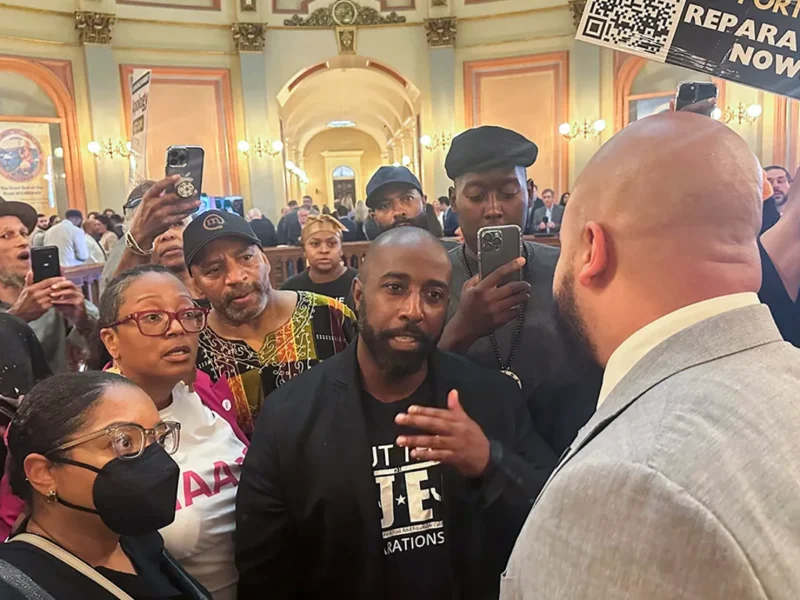The Red Wave In Minority Voting
A recent USA Today poll found that the GOP generic House candidate had a 4% lead over the generic Democrat House candidate 49% to 45% among likely voters. In context, this is the largest GOP lead going into the midterms since 2014. The GOP lead represents a slew of undecided voters swinging against the governing party largely due to economic concerns. Curiously, the same poll suggested that the GOP may earn up to 21% of the African-American vote and 40% of the Latino vote. In the 2020 Presidential race President Trump earned an unprecedented 12% of the African-American vote and 32% of the Latino vote. The implications of these polls for the coming midterms do not bode well for the Democrat Party. Many Democrat candidates are heavily embattled holding just slight leads in polls over their GOP rivals.
If 40% of Latino voters do cast their votes for the GOP, that alone holds very strong implications for races in states with large Latino minorities like Arizona and Nevada. African-American voters will make a great difference in states like Georgia, North Carolina, and Michigan. These numbers suggest minority voters could put GOP candidates over the top in key battleground races. Perhaps more depressing for Democrat candidates is the slide of undecided voters to the GOP. A generic House candidate USA Today poll conducted in July, in which the Democrats held the lead, found that 16% of voters remained undecided. Now just 6% of voters are undecided and the 10% who made up their minds swung very much to the right. If undecided voters lean any farther to the right, combined with minority voters, the GOP could see an historic result. This poll suggests there may very much be a red wave coming.
Gubernatorial Races
In Pennsylvania and Michigan, Democrat Gubernatorial candidates have seen their leads slowly evaporate as election day nears. Michigan’s Gretchen Whitmer is an incumbent governor who, if her record were solid, should hold a comfortable lead. Yet, the race has narrowed in recent weeks. In Arizona, Kari Lake is leading her opponent Kathie Hobbs comfortably headed into the final stretch. In Kansas, purportedly moderate incumbent Democrat Governor Laura Kelly is facing a strong challenge from Attorney General Derek Schmidt. Even New York’s gubernatorial race does not appear to be entirely beyond the pale for the GOP. A recent Quinnipiac Poll of likely voters in New York published on October 18th, found that incumbent Democrat Governor Kathy Hochul held just a 4% lead over GOP challenger Lee Zeldin. Independents in that race favor Zeldin 57%-37%. A four point deficit is not insurmountable just over a week out from election day.
Senate Races
In the US Senate, the prospects for the GOP are the dimmest. This is a class of senators dominated by the GOP wherein Republicans must defend many seats, including five wherein incumbents have retired, whilst trying to achieve a net gain. The US Senate is currently evenly divided between Republicans and Democrats and the Independents who caucus with the latter. This means Vice President Kamala Harris’ tie breaking vote decides control of the Senate. The GOP thus requires a net gain of only a single seat to gain control of the leadership of that house, and control of its agenda and committees. The GOP must defend seats in Pennsylvania and North Carolina, for example, that are historically close states. The GOP does look to be on track to defend both seats, but only just. To gain a seat, the GOP must win one or more close races in Arizona, Georgia, and Nevada.
Arizona is promising for the GOP. In recent polls the race between incumbent Democrat Senator Mark Kelly and Republican challenger Blake Masters has narrowed to just a 2% lead. In Georgia, a Monmouth poll published October 26th found incumbent Democrat Senator Raphael Warnock held a 5% lead over GOP challenger Herschel Walker, a sports celebrity. Perhaps the most surprising race is that of Nevada wherein GOP candidate Adam Laxalt is gaining ground against his Democrat opponent Cortez Masto. Published polls continue to show Laxalt trailing by double digits, but the Democrat Party has begun to pump tens of millions of dollars into the race which suggests internal polling shows something else entirely. The GOP needs only hold its current seats and gain one of these three to assume the majority in the Senate.
In perhaps a strange twist two Senate elections have become complicated as in Alaska Republican voters are looking to oust Barbara Murkowski. The state’s new open party top four primary and ranked voting system have already led to trouble in Alaska with a Democrat House candidate winning the state’s lone House seat in a special election earlier this year, in spite of the fact that over 60% of the voters voted for Republican candidates in the first round. Recent polls found that Murkowski and GOP challenger Kelly Tchibaka, are closely tied for the first round of voting 42%-41%. In second round voting, however, Murkowski earns 56%. Ranked voting, open top two primaries, and other election innovations are often advanced to prevent the election of popular conservative candidates.
In Utah, another strange twist is afoot wherein Evan McMullin, who ran for President in 2016 purportedly to the right of Donald Trump, is running for Senate against incumbent Senator and conservative celebrity Mike Lee. Curiously, the Democrats are not fielding a candidate and are actively raising money for McMullin. While McMullin has not stated that he would caucus with the Democrats if elected, with the Senate majority so closely held, GOP voters don’t want to find out. This may very well be the last stand of the Never Trumpers. Recent polls show Lee has a comfortable lead, but with no Democrat on the ballot and the possibility that more centrist Republicans could be tricked into voting for McMullin, the race has taken a curious twist.
House Races
The Democrat majority in the House is just 5 seats. A six seat gain by the GOP will change the leadership of the House. Given where USA Today puts the poll numbers, GOP control of the House next year is almost a foregone conclusion. But if undecided voters continue to swing GOP and with the help of historic numbers of minority voters, there could be a more sizable gain for the GOP. All things being equal, in a year in which voters were mildly upset with the governing party a 15-20 seat gain for the GOP challengers might be expected. Poll numbers being where they are, a 40-50 seat red wave is not out of the question. It is possible that the Rio Grande Valley of Texas, once a Democrat stronghold, could turn red. The impact of Latino voters there is likely to be felt very strongly. In a recent special election there, Republican challenger Mayra Flores beat a Democrat in a Democrat-leaning seat. Mayra is the first Mexican-born member of the House of Representatives and she has an “R” next to her name. These prospects shatter the woke far left’s racial narrative about the GOP.
All across the country, people are disaffected by the economic hardship, open borders, rising crime, the general feeling that our leaders do not care. Perhaps voters gleaned this message from Democrat ads and narratives that focus on their fantasies about January 6th and advertise their radical views on abortion. Both issues that are non-starters with average voters in a time of economic decline and hardship. While most voters do want abortion to be legal for some period of pregnancy or under specific circumstances, a majority support a heartbeat ban (6 weeks) and only 9% support the unrestricted abortion policy advanced by the radical left. These delusional approaches to the election are a real gift to the GOP.
Looking Forward to 2024
It is a safe analysis to argue that Donald Trump plans to seek reelection. He has hinted at this several times over the past few years, and at a recent rally he stated: “I may have to do it again.” Given the current sentiments among Republican voters, it is safe to say the Republican nominee in 2024 will either be Donald Trump, or his chosen endorsee. While nearly 6 in 10 voters continue to say they do not want the former President to run again, about as many as do not want President Biden to seek reelection, Trump stands a very real chance of making a comeback. As I postulated in an article two years ago, Donald Trump could be the Grover Cleveland of the 21st Century. Cleveland is the only President to serve two non-consecutive terms as President from 1885-89 and 1893-97. This was largely due to the dearth of capable candidates in the Democrat Party of the day, but is one remarkable thing about Cleveland.
With minority voters swinging ever rightward and independents and undecided voters turning to the GOP to bring about a change in direction in the upcoming 2022 midterm election, GOP prospects for 2024 are good. Donald Trump may very well overcome his many critics and haters to return to the Oval Office.







